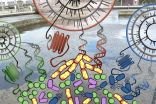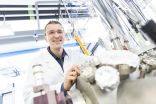A colorful gathering of middle-aged stars
2014-11-26
(Press-News.org) NGC 3532 is a bright open cluster located some 1300 light-years away in the constellation of Carina(The Keel of the ship Argo). It is informally known as the Wishing Well Cluster, as it resembles scattered silver coins which have been dropped into a well. It is also referred to as the Football Cluster, although how appropriate this is depends on which side of the Atlantic you live. It acquired the name because of its oval shape, which citizens of rugby-playing nations might see as resembling a rugby ball.
This very bright star cluster is easily seen with the naked eye from the southern hemisphere. It was discovered by French astronomer Nicolas Louis de Lacaille whilst observing from South Africa in 1752 and was catalogued three years later in 1755. It is one of the most spectacular open star clusters in the whole sky.
NGC 3532 covers an area of the sky that is almost twice the size of the full Moon. It was described as a binary-rich cluster by John Herschel who observed "several elegant double stars" here during hisstay in southern Africa in the 1830s. Of additional, much more recent, historical relevance, NGC 3532 was the first target to be observed by the NASA/ESA Hubble Space Telescope, on 20 May 1990.
This grouping of stars is about 300 million years old. This makes it middle-aged by open star cluster standards [1]. The cluster stars that started off with moderate masses are still shining brightly with blue-white colours, but the more massive ones have already exhausted their supplies of hydrogen fuel and have become red giant stars. As a result the cluster appears rich in both blue and orange stars. The most massive stars in the original cluster will have already run through their brief but brilliant lives and exploded as supernovae long ago. There are also numerous less conspicuous fainter stars of lower mass that have longer lives and shine with yellow or red hues. NGC 3532 consists of around 400 stars in total.
The background sky here in a rich part of the Milky Way is very crowded with stars. Some glowing red gas is also apparent, as well as subtle lanes of dust that block the view of more distant stars. These are probably not connected to the cluster itself, which is old enough to have cleared away any material in its surroundings long ago.
This image of NGC 3532 was captured by the Wide Field Imager instrument at ESO's La Silla Observatory in February 2013.
INFORMATION:
Notes
[1] Stars with masses many times greater than the Sun have lives of just a few million years, the Sun is expected to live for about ten billion years and low-mass stars have expected lives of hundreds of billions of years -- much greater than the current age of the Universe.
More information
ESO is the foremost intergovernmental astronomy organisation in Europe and the world's most productive ground-based astronomical observatory by far. It is supported by 15 countries: Austria, Belgium, Brazil, the Czech Republic, Denmark, France, Finland, Germany, Italy, the Netherlands, Portugal, Spain, Sweden, Switzerland and the United Kingdom. ESO carries out an ambitious programme focused on the design, construction and operation of powerful ground-based observing facilities enabling astronomers to make important scientific discoveries. ESO also plays a leading role in promoting and organising cooperation in astronomical research. ESO operates three unique world-class observing sites in Chile: La Silla, Paranal and Chajnantor. At Paranal, ESO operates the Very Large Telescope, the world's most advanced visible-light astronomical observatory and two survey telescopes. VISTA works in the infrared and is the world's largest survey telescope and the VLT Survey Telescope is the largest telescope designed to exclusively survey the skies in visible light. ESO is the European partner of a revolutionary astronomical telescope ALMA, the largest astronomical project in existence. ESO is currently planning the 39-metre European Extremely Large optical/near-infrared Telescope, the E-ELT, which will become "the world's biggest eye on the sky".
Links
Photos of the MPG/ESO 2.2-metre telescope: http://www.eso.org/public/images/archive/search/?adv=&subject_name=mpg
Other photos taken with the MPG/ESO 2.2-metre telescope: http://www.eso.org/public/images/archive/search/?adv=&facility=15
Photos of La Silla: http://www.eso.org/public/images/archive/category/lasilla/
Contact
Richard Hook
ESO, Public Information Officer
Garching bei München, Germany
Tel: +49 89 3200 6655
Cell: +49 151 1537 3591
Email: rhook@eso.org
[Attachments] See images for this press release:

ELSE PRESS RELEASES FROM THIS DATE:
2014-11-26
Jülich, 26 November 2014 - In metals such as copper or aluminium, so-called conduction electrons are able to move around freely, in the same way as particles in a gas or a liquid. If, however, impurities are implanted into the metal's crystal lattice, the electrons cluster together in a uniform pattern around the point of interference, resembling the ripples that occur when a stone is thrown into a pool of water. Scientists in Jülich have, with the help of computer simulations, now discovered a combination of materials that strengthens these Friedel oscillations ...
2014-11-26
The Luxembourg Centre for Systems Biomedicine (LCSB) has succeeded for the first time in describing the complex relationships within an ecosystem in unprecedented detail. For their work, carried out in collaboration with US and Luxembourg partners, their model ecosystem was a "biological wastewater treatment plant". In it live numerous species of bacteria which are involved in the wastewater purification process.
LCSB director Prof. Dr. Rudi Balling stresses the medical importance of these research efforts: "Bacterial ecosystems also play a major role in our health. ...
2014-11-26
Although the van der Waals force was discovered around 150 years ago, it is still difficult to quantify when predicting the behaviour of solids, liquids, and molecules. Precise measurements were only possible up to now for single atoms or macroscopic objects. However, the van der Waals forces are particularly important at intermediate size, where they crucially co-determine the behaviour of complex molecules, such as biomolecules and proteins. They are also responsible for the functioning of certain adhesives and are the reason why geckos can adhere so amazingly well to ...
2014-11-26
This news release is available in French. The way people with autism spectrum disorder (ASD) gather information - not the judgement process itself - might explain why they gain different perceptions from peoples' faces, according to a new study from Hôpital Rivière-des-Prairies and the University of Montreal. "The evaluation of an individual's face is a rapid process that influences our future relationship with the individual," said Baudouin Forgeot d'Arc, lead author of the study. "By studying these judgments, we wanted to better understand how people with ...
2014-11-26
The precise movements of a young hammerhead shark have been tracked for the first time and are published in the open access journal Animal Biotelemetry. The study, which ran over a 10-month period, reveals important gaps in current efforts to protect these endangered sharks and suggests key locations that should be protected to help the survival of the species.
Hammerhead sharks, which have recently received new protections from the UN Convention on the Conservation of Migratory Species of Wild Animals, are experiencing drastic population declines in excess of 90% in ...
2014-11-26
The expression of a gene involved in female birds' color vision is linked to the evolution of colorful plumage in males, reports a new study from the University of Chicago. The findings, published Nov. 26 in the Proceedings of the Royal Society B, confirm the essential role of female color perception in mate selection and sexual dimorphism.
"This is the first time an aspect of the visual system in birds has been directly associated with plumage evolution," said Natasha Bloch, PhD, who authored the study while a graduate student in ecology & evolution at the University ...
2014-11-26
Deaf teenagers have better reading skills if they were identified as deaf by the time they were nine months old, research from the University of Southampton has shown.
The Southampton team has been studying the development of a group of children who were identified with permanent childhood hearing impairment (PCHI) at a very early age in a pilot screening programme conducted in Southampton and London in the 1990s.
Follow up assessments when the children were aged eight showed those who were screened at birth had better language skills than those children who were not ...
2014-11-26
Rheumatic heart disease (RHD) - the most common acquired heart disease in children in many countries of the world - is being neglected and poorly treated, according to new findings from the Global Rheumatic Heart Disease Registry (the REMEDY study), published online today (Wednesday) in the European Heart Journal [1].
RHD accounts for up to 1.4 million deaths every year, with the highest numbers of people affected by it and dying occurring in low and middle-income countries. It is triggered by rheumatic fever (RF) that can be prevented and controlled. RF is preceded by ...
2014-11-26
The potential to quickly diagnose children with type 1 diabetes before the onset of serious illness could be achieved using a simple, non-invasive breath test, according to new research published today.
In one of the most comprehensive breath-based studies of children with type 1 diabetes performed to date, a team of researchers from Oxford, UK have linked a sweet-smelling chemical marker in the breath with a build-up of potentially harmful chemicals in the blood that accumulate when insulin levels are low.
It is hoped these results--linking an increased level of breath ...
2014-11-26
University of Adelaide-led research will help pinpoint the impact of waves on sea ice, which is vulnerable to climate change, particularly in the Arctic where it is rapidly retreating.
Published today in the Proceedings of the Royal Society A, the research reports the first laboratory experiments testing theoretical models of wave activity in frozen oceans.
"Sea ice is both an indicator and agent of climate change," says project leader Dr Luke Bennetts, Research Fellow in the School of Mathematical Sciences.
"Sea ice covering the ocean surface is white and efficiently ...
LAST 30 PRESS RELEASES:
[Press-News.org] A colorful gathering of middle-aged stars




